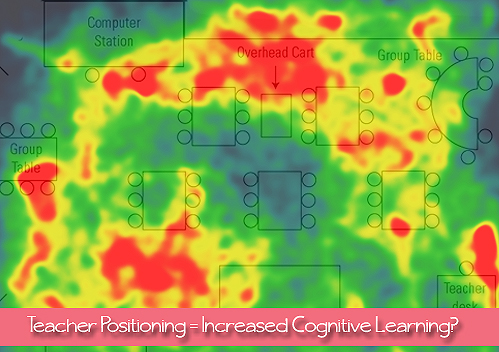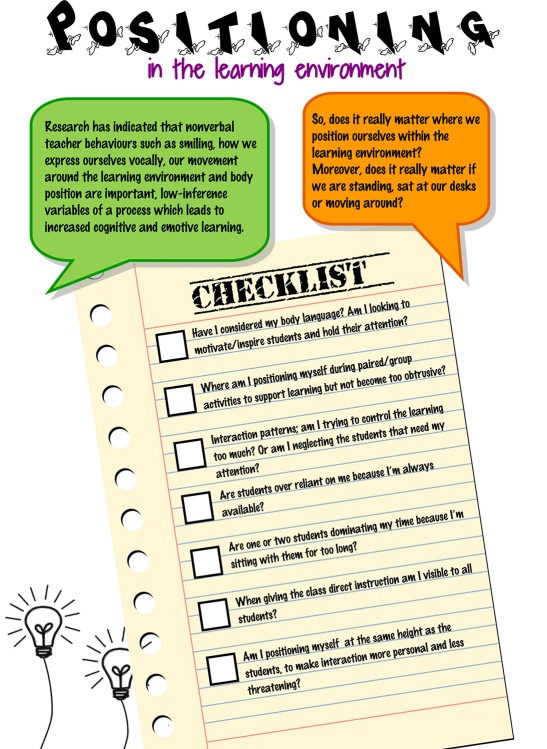Research has suggested that nonverbal teacher behaviors such as smiling, how we express ourselves vocally, our movement around the learning environment and the actual position of our body are extremely important, low‐inference variables of a process which leads to increased cognitive and emotive learning. There has been extensive research, hundreds of blogs written and endless CPD on the theory and application of student positioning/seating plans and other pedagogical strategies such as Kagan structures to enhance engagement in learning, most of which have significantly developed pedagogy over time. But what about our own actions as teachers? What part is our physical positioning and emotive gestures playing within the process of students’ learning?
“does it really matter if we are standing, sat at our desks or constantly moving around?”
Does it really matter where we position ourselves within the learning environment? Moreover, does it really matter if we are standing, sat at our desks or constantly moving around? Where we choose to position ourselves will depend on the aim of the learning activity. Quite often our main intention will want to be the focus of all of our learners’ attention, however, there will be times where we want to be working with groups, pairs or one to one with students in the class. There will also be occasions when we will want to deliberately be low key to allow deep learning to evolve. For that reason we will need to transition through different positions accordingly. Two crucial elements to consider are:
- Our physical positioning
- Our interaction patterns
Physical Positioning
Have you ever considered where you position and how you present yourself and what impact this has on holding students attention? More importantly what could be the effect this has on their learning? What about the teacher who always sits at their desk and teaches fantastic lessons? I’m pretty sure every school has got at least one! What about the teacher who never sits still and is always moving at 100 miles per hour around the room? How do these extremes positively or negatively influence cognitive learning behaviours? One obvious choice is to stand at the front of the room and talk at students in the hope that they listen, after all, there is no a preferred style of teaching. So, what about the teacher who always sits at their desk when teaching; is this teacher absolutely certain that all learners are engaged? Perhaps a more significant aspect to think about is the message that this is giving to students. One could argue that at the beginning of a lesson this could create a welcoming atmosphere, however, we do need to guard against giving students the impression that we lack interest and motivation.
extremes positively or negatively influence cognitive learning behaviours? One obvious choice is to stand at the front of the room and talk at students in the hope that they listen, after all, there is no a preferred style of teaching. So, what about the teacher who always sits at their desk when teaching; is this teacher absolutely certain that all learners are engaged? Perhaps a more significant aspect to think about is the message that this is giving to students. One could argue that at the beginning of a lesson this could create a welcoming atmosphere, however, we do need to guard against giving students the impression that we lack interest and motivation.
Don’t get me wrong, of course there are times when sitting is a good idea. Sometimes standing can distract students so sitting in a place which is easily accessible, perhaps in the middle of the class instead of at the front, means you are not distracting students but instead leaving yourself accessible for all. Leaning in to groups also has it’s advantages, showing that we are mobile and if we are physically the same height as our students it makes interactions less threatening. Finally, leaning or crouching gives us a tool to position ourselves in the heart of learning without moving chairs all the time, which in itself can be a big distraction.
Interaction Patterns
Interaction patterns are absolutely linked to pedagogy, the structure of learning and how you have planned for progress. As teachers, interaction is integral to what we do, but how we do it? I believe it’s a case of control vs. carelessness. Have you ever found yourself becoming too involved in learning episodes that could have been more student-centred? whereby you are actually inhibiting learning through trying to have too much control either intentionally or unintentionally, because I have. On the flip side, have you ever not been involved enough to steer and help manage deep learning and misconceptions? I have been here too and feel this is carelessness on my part. The position we adopt in our respective learning environments is critical to how we can provide learners with a balanced amount of attention, emotional and physical space.
“As teachers, interaction is integral to what we do”
Here’s a checklist that may help you consider all of the above and hopefully enable you to reflect on positioning as a tool to enhance learning for all your students. Click HERE to download a copy.
How we choose to position ourselves in our learning environment gives a clear message to our students and I would argue most certainly has some impact on the progress they make. Does it increase cognitive learning? Without extensive action research to support this it’s hard to answer. However, it’s worth remembering that although we always want to be available for our students, there is a call for balance with regards to the attention they are given, and this can be established through positioning ourselves according to the requirements of the learning taking place.
Follow @gary_s_king


Discussion
No comments yet.